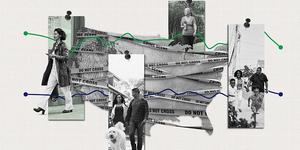For people here outside the old hierarchy, the issue that the United States and Britain used to justify the war was never a prime concern. Despite the use of chemical weapons against the Iraqi Kurds, the weapons that terrified Iraqis most were the pistol, the garrote, and the gallows.
--John F. Burns (writing from Baghdad), The New York Times, Nov. 16, 2003
Forty mass graves have already been identified in Iraq since Saddam Hussein's regime was ousted by coalition forces; there are perhaps a total of 260 such graves nationwide. These tragic discoveries have led to much speculation about just how many victims were executed under Hussein's rule.
"We believe, based on what Iraqis have reported to us, that there are 300,000 dead -- and that's the lower end of the estimates," said Sandra Hodgkinson, director of human rights in the Coalition Provisional Authority's Office of Human Rights and Transitional Justice. Others, including some Iraqis, place the total number of Iraqis executed in the Hussein era closer to 500,000. There are as many as 1.3 million persons missing, including those executed, those killed in wars (an estimated 375,000 in the 1980-1988 war with Iran, and another 100,000 in the 1990-1991 Gulf War), and those who may have defected.
This in a country of just over 25 million people.
Most of the mass gravesites already discovered hold Baathist regime victims from the predominantly Shiite south and Kurdish north. But what about Baghdad, which was far too close to the center of the regime's power to play a role in uprisings such as the unsuccessful Shiite revolt following the Gulf War? Were the residents of the country's capital spared the terror of reprisal executions that other regions witnessed?
Gallup asked a scientifically representative sample of the city's 6.39 million residents whether any member of their household had been executed under the previous regime. An astonishing 6.6% said yes.
More Than 60,000 Executed in Baghdad Alone?
Our survey found that the average Baghdad household has 6.9 residents. Assuming one execution per victimized household, the reported execution incidence of 6.6% projects to roughly 61,000 executions over the course of Hussein's 24-year rule. This is a shocking number -- nearly 1% of the capital city's current population, and double the number of mass grave victims discovered in Bosnia. Is it a credible projection for metropolitan Baghdad?
Even if the data are adjusted for some degree of over-reporting -- on the assumption that some respondents may have defined "household" (usra) in broader terms than simply those family members residing at their own addresses -- emerging evidence suggests that this projection is realistic.
An enormous number of Iraqis were imprisoned by the former regime: Tens of thousands, for example, were freed in a single amnesty announced by Hussein in October 2002. In addition to those explicitly executed, uncounted numbers died by other means while in captivity. Prisoners were routinely subjected to beatings and torture and systematically ravaged by disease through severe malnourishment and overcrowding. For most, the precise manner of their deaths may never be learned by their families, but "execution" is nonetheless an apt description of their fate.
There is also a growing body of evidence and eyewitness testimony regarding Baghdadis executed in a more direct manner. Some examples:
- A gravedigger at a Baghdad cemetery interviewed by Agence France-Presse described in detail the execution victims he interred personally. "There are another five cemeteries in Baghdad with secret gravesites," he explained, before estimating that "in this city alone there are about 6,000 (political) corpses."
- An officer at one Baghdad prison told Britain's ITV News that "he had no idea how many people were killed" in his prison, but continued, "it must have been thousands."
- A Baghdad cemetery manager told Agence France-Presse that he would periodically receive 10 to 15 corpses -- "all political," in his words -- from Baghdad's massive Abu Ghraib prison. "The last corpse interred was number 993."
- In early June, a mass grave was discovered on the banks of the Diyala River near a site used by Iraqi intelligence services, the victims still dressed in striped prison uniforms.
- Others executed at Baghdad's largest prison were buried on the spot. Newsday reporter Matthew McAllester was briefly imprisoned in Abu Ghraib before being freed in the regime's final days. He returned to the prison in late spring and witnessed "bodies of Iraqi prisoners on my wing being disinterred just outside what used to be our section of the prison."
- Executions weren't limited to those placed under arrest. According to an Iraqi veteran interviewed by The Dallas Morning News, at least three massacres were conducted in Saddam City (now Sadr City) within the past decade, during one of which 700 Shiite demonstrators were killed.
